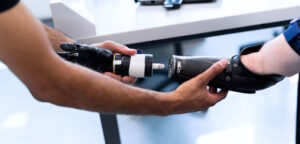How To Protect Your Prosthesis in the Rain, Pool, or Shower
If you wear a prosthesis, it’s natural to wonder: Can prosthetics get wet? Whether you’re caught in the rain, planning a day at the lake, or simply taking a shower, moisture can impact how your prosthesis functions and how comfortable it feels. The good news is that modern prosthetics are designed with durability in mind — and some are even made to handle water directly.
At Cotton Orthotic & Prosthetic Associates, our team often helps patients understand which components are safe to get wet and how to protect their prosthesis from everyday weather and water exposure. Here’s what you need to know about keeping your device safe, dry, and performing its best.
Understanding How Water Affects Prosthetics
Not all prosthetics react to water in the same way. Some can handle light moisture or splashes, while others are fully waterproof and built for swimming or showering.
Water-resistant prosthetics can tolerate minimal moisture, like rain or sweat, but shouldn’t be submerged. Waterproof prosthetics, on the other hand, are sealed and designed to withstand full immersion in water.
Most prosthetic systems include several components that respond differently to water exposure:
- Socket: The part that fits against your skin, often lined with a gel or silicone liner that must stay clean and dry to prevent irritation.
- Liner: Moisture buildup here can lead to skin breakdown, so it’s important to dry it thoroughly after exposure.
- Joints: Electronic or mechanical components may corrode if exposed to water.
- Prosthetic foot or hand: Many are water-resistant, but foam covers or cosmetic shells can absorb water and take time to dry.
If you’re unsure whether your prosthetic can get wet, always check with your orthotist or prosthetist before exposure. You can learn more about our prosthetic services on our website.
Types of Prosthetics and Their Water Resistance
Every prosthesis is built with specific materials, mechanics, and functions — and these factors determine how it reacts to water.
- Below-the-Knee Prosthetics: These often include foam covers that can absorb moisture. The internal foot mechanism may not be waterproof unless specifically designed for it.
- Above-the-Knee Prosthetics: Microprocessor-controlled knees, such as those used for smoother walking patterns, often have electronic components that must stay dry. However, some models are now water-resistant or waterproof.
- Upper-Limb Prosthetics: Myoelectric hands and arms typically use sensitive sensors and wiring that can be damaged by water. Body-powered options, however, may handle light exposure better.
Manufacturers have responded to patient needs with waterproof and water-resistant prosthetics. For example, some prosthetic feet are built for swimming or water sports, and certain microprocessor knees can handle wet environments safely.
Everyday Weatherproofing Tips for Your Prosthesis
Kansas weather can swing from humid summers to icy winters, so a few simple habits help keep prosthetics performing well in wet conditions:
- Use waterproof covers or sleeves: A rain cover or swim sleeve prevents moisture from reaching sensitive components—especially helpful for commuters searching “prosthetics near me” and navigating unpredictable weather.
- Keep the socket and liner dry: Moisture trapped against the skin can cause irritation. Liners should be patted dry and allowed to air dry fully before re-wear.
- Clean after exposure: After rain, snow, or splashes, metal parts and joints benefit from a quick wipe-down with a soft towel to reduce corrosion risk.
- Pay attention to storage: Garages and bathrooms can be humid. A cool, dry place extends the life of prosthetics and accessories.
- Plan for seasons: In Overland Park, slush and road salt in winter can leave residue on feet and joints. A gentle rinse with clean water helps protect moving parts.
When To Consider a Waterproof Prosthetic Option
A dedicated waterproof setup can be a game-changer for active lifestyles that include:
- Regular water exposure: Swimming, boating at local lakes, or hydrotherapy often justify a secondary, water-ready limb.
- Independent showering: Waterproof components simplify daily routines and reduce worry about splashes.
- Outdoor work and sports: Gardeners, anglers, and walkers benefit from corrosion-resistant hardware.
Many patients weighing “prosthetic companies near me” or “orthotics and prosthetics near me” discover that a secondary activity limb — built with titanium, stainless hardware, or sealed electronics — delivers the right mix of durability and convenience. A brief fitting conversation with a certified prosthetist clarifies which components match activity goals and budget.
Get Expert Prosthetic Care in Overland Park
If you’re searching for “prosthetics near me” in Overland Park, you deserve a partner who listens, explains options clearly, and supports long-term mobility goals. Cotton Orthotic & Prosthetic Associates offers individualized fittings, maintenance, and recommendations for waterproof or water-resistant setups — so daily life, lake days, and Kansas weather feel navigable.
Take the next step today. Request a consultation to discuss waterproof components, secondary activity limbs, or upgrades.







